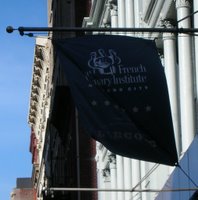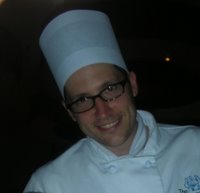WINE LECTURE
 Tonight is our wine lecture. But I'm off to school early to help set up the school kitchens for the Level Four finals. No cooking for us until we become the new Level Four students.
Tonight is our wine lecture. But I'm off to school early to help set up the school kitchens for the Level Four finals. No cooking for us until we become the new Level Four students.More bacchanalia after class and on the jump...
A few of us volunteered to help set up for the Level Four finals before our wine lecture. The final is set up like the midterm I took at the end of May. The differences are that there are more dishes to remember, the final takes place in the downstairs kitchens (the Level Two kitchen as well as the restaurant kitchens instead of just the Level One kitchen) and this is for all the marbles.
When we arrived we helped portion out ingredients into about 21 different hotel pans, one per student. We also set up a station in the Garde Manger (Appetizer) kitchen with salt, spices, herbs, vinegar and oil. It took a while to portion out the meats, fish and vegetables and when we were done it was about time to head upstairs for the lecture.
Our instructor took us through detailed explanations of alcoholic fermentation and the processes for making fermented beverages and grain spirits. She then talked about how beer is made, described the history and production of beer: ales, lagers and lambecs. She detailed the differences between ale yeast and lager yeast, ales are made with top-fermenting yeasts (the more traditional method going back over time) while lagers are made with bottom-fermenting yeasts. I found it interesting especially to consider that before the water purification in recent history, beers and wines were the only really safe way to get "watered" so to speak.
She also talked about wines and the differences between old world wines and new world wines, the differences between how wines from these two worlds are labeled, standard and specialty style wines, the major grapes, how climate can affect taste. She told us that old world style wines have lower alcohol content and moderate fruit flavors while new world style wines have higher alcohol content and more intense fruit flavor. Alas, though we sat during the lecture with six wine glasses in front of us, we volunteers had unknowingly also volunteered to help the Level Four students during their final as well-- we'd be taking their dishes out on service trays to the judges who would be grading their food in the restaurant dining room.
As much as we were disappointed not to be tasting the different wines upstairs with the rest of our classmates I was also dissapointed that I was missing the part of the lecture that described how wines are matched with different food dishes. Fortunately, we were also given handouts which went over some of what we missed. The papers advise to:
- Match the intensity of the wine to the intensity of the dish
- Remember the effects of salt, fat and spicy heat on wine
- Factor in the basics of how the senses operate
- Choose a strategy- compare or contrast
FAT According to the handout, fat and oils, "minimize the astringent effect of tannin. By drying the mouth of saliva, tannin can limit the sensations perceived by the taste buds and the olfactory center. The fat in cheeses and meats softens red wine' harshness, and tannic wines will cut through the oily mouth feel of rich foods and cleanse the palate."
SPICY HEAT According to the handout, spicy food is difficult to pair with wine because, "the combination can create a painful sensation. The fundamental problem in pairing wine with spicy food is wine's high alcohol content. Beer often works better than wine with the spiciest cuisines because it has a lower alcohol content." It advises to strategies to pairing wines with spicy food, "choosing light-bodied wines and choosing wines with noticeable sweetness." While alcohol will inflame the burning sensation of hot foods, sugar will tame it.
HOW THE SENSES OPERATE
CHOOSIG A STRATEGY
PATTERNS OF WINE & FOOD INTERACTION
In addition, the previous lecture is supposed to have been recorded so I'll be trying to get a copy of it. For the record, the wines that were tasted were:
Riesling, Bonny Doon Pacific Rim, Washington State
Average Retail Price: $12 Vintage: 2004
Alc % By Vol: 12.5
Sauvignon Blanc, Geyser Park, Alexander Valley, Sonoma County
Average Retail Price: $13.50 Vintage: 2005
Alc % By Vol: 13
Chardonnay, St. Francis, Sonoma County, California
Average Retail Price: $11 Vintage: 2004
Alc % By Vol: 14.2
Pinot Noir, Echelon, Central Coast, California
Average Retail Price: $13 Vintage: 2005
Alc % By Vol: 13.8
Merlot, Clos du Bois, Sonoma County, California
Average Retail Price: $13 Vintage: 2003
Alc % By Vol: 13.5
Cabernet Sauvignon, Clos du Val, Napa Valley, California
Average Retail Price: $28 Vintage: 2002
Alc % By Vol: 13.5
The wines were tasted with: goat cheese, proscuitto, smoked salmon, jelly beans, popcorn, kosher salt, butter, and hot sauce.
It was certainly revelatory to watch the students as they neared the finish line. We got the distinct feeling that the final was nore difficult than had been inticipated .It seemed as though while in the end everyone may have done well enough, there was a little panic and struggling in the final moments (not that I'm saying I won't be in a panic in those final seconds too). Tins weren't sprayed and flans stuck, carrots meant as garnish almost garnished the floor, and consommes didn't clear.
While having prepared the Level Four students won't clue US in to which dishes we'll be cooking in October it was comforting to see how much room we'll have to do our cooking ( about a full stove per person). But we've still got some things to learn first before our final in October.





0 Comments:
Post a Comment
<< Home